

COVID-19: Questions and answers. Alert Level 1 On Monday 8 June at 11.59 pm New Zealand moved to Alert Level 1.
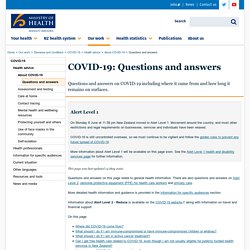
Movement around the country, and most other restrictions and legal requirements on businesses, services and individuals have been relaxed. COVID-19 is still uncontrolled overseas, so we must continue to be vigilant and follow the golden rules to prevent any future spread of COVID-19. More information about Alert Level 1 will be available on this page soon. See the Alert Level 1 health and disability services page for further information. This page was last updated 14 May 2020. Questions and answers on this page relate to general health information. More detailed health information and guidance is provided in the Information for specific audiences section. Explainer: How the coronavirus tricks its way into human cells. : Four months on, here's what we've learned about Covid-19 so far. Since a new coronavirus was detected havoc has been unleashed across the globe.

Countries have closed borders, international travel has ceased, hospitals have become overwhelmed in some nations, and more than 100,000 people have died worldwide. It's been about four months since Covid-19 first emerged. Here's some of what scientists have learned about the virus in that time, what's changed in our understanding, and the unknowns we're still yet to uncover. Coronavirus Questions Answered: What We Know About COVID-19. COVID-19: What is a virus? How do they spread? How do they make us sick? Viruses are the most common biological entities on Earth.
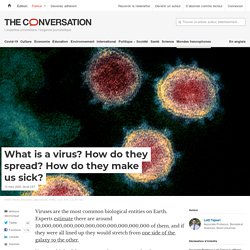
Experts estimate there are around 10,000,000,000,000,000,000,000,000,000,000 of them, and if they were all lined up they would stretch from one side of the galaxy to the other. You can think of them as nature’s own nanotechnology: molecular machines with sizes on the nanometre scale, equipped to invade the cells of other organisms and hijack them to reproduce themselves.
While the great majority are harmless to humans, some can make you sick and some can even be deadly. Are viruses alive? Viruses rely on the cells of other organisms to survive and reproduce, because they can’t capture or store energy themselves. Outside a cell, a virus it wraps itself up into an independent particle called a virion. When a virion attaches to a suitable host cell – this depends on the protein molecules on the surfaces of the virion and the cell – it is able to penetrate the cell. Does this “life cycle” make viruses alive? What the coronavirus does to your body that makes it so deadly. COVID-19 is caused by a coronavirus called SARS-CoV-2.

Coronaviruses belong to a group of viruses that infect animals, from peacocks to whales. They’re named for the bulb-tipped spikes that project from the virus’s surface and give the appearance of a corona surrounding it. A coronavirus infection usually plays out one of two ways: as an infection in the lungs that includes some cases of what people would call the common cold, or as an infection in the gut that causes diarrhea. COVID-19 starts out in the lungs like the common cold coronaviruses, but then causes havoc with the immune system that can lead to long-term lung damage or death.
What is coronavirus and Covid-19? An explainer. "Novel coronavirus" is the proper term for this brand-new virus wreaking havoc on our unprepared world.

But you can also call this nasty villain by its scientific name: severe acute respiratory syndrome coronavirus 2, or SARS-CoV-2 for short. Becoming infected with SARS-CoV-2 can trigger a potentially deadly respiratory disease called Covid-19, an illness which presents with three main acute symptoms: fever, a deep, dry cough and a shortness of breath which can become quickly life-threatening. Other symptoms can mimic a cold or the flu. Covid-19 seems to strike the elderly and immunocompromised the hardest, along with any of us with underlying health conditions such as diabetes, heart and lung disease.
But the young shouldn't take anything for granted -- there have been numerous deaths among people aged 20 to 50, as well as a very few among children. -19: the science of soap. One of the best protections we have against SARS-CoV-2, the coronavirus that causes the severe respiratory disease Covid-19, is to wash our hands, well and often.

That’s because when it comes to virus-busting, soap is an oldie but a goodie. And it turns out that soap is particularly effective against coronaviruses. Photo: Picture Partners Find Our Changing World on Apple Podcasts, Spotify, Stitcher, iHeartRADIO, Google Podcasts, RadioPublic or wherever you listen to your podcasts “We’ve got to find relatively benign molecules that are deadly to viruses - and of everything that is out there soap is a damn good one,” says chemist Professor Allan Blackman, from the Auckland University of Technology.
Coronavirus Infections—More Than Just the Common Cold. Human coronaviruses (HCoVs) have long been considered inconsequential pathogens, causing the “common cold” in otherwise healthy people.
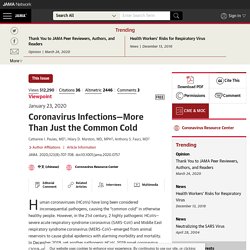
However, in the 21st century, 2 highly pathogenic HCoVs—severe acute respiratory syndrome coronavirus (SARS-CoV) and Middle East respiratory syndrome coronavirus (MERS-CoV)—emerged from animal reservoirs to cause global epidemics with alarming morbidity and mortality. In December 2019, yet another pathogenic HCoV, 2019 novel coronavirus (2019-nCoV), was recognized in Wuhan, China, and has caused serious illness and death.
The ultimate scope and effect of this outbreak is unclear at present as the situation is rapidly evolving. The Coronavirus Explained & What You Should Do. Coronavirus. There are many different viruses.
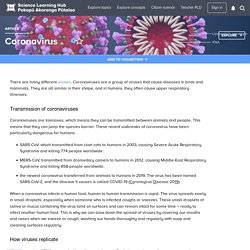
Coronaviruses are a group of viruses that cause diseases in birds and mammals. They are all similar in their shape, and in humans, they often cause upper respiratory illnesses. Transmission of coronaviruses Coronaviruses are zoonoses, which means they can be transmitted between animals and people. This means that they can jump the species barrier. Coronavirus: what do scientists know about Covid-19 so far? Coronaviruses have been causing problems for humanity for a long time.
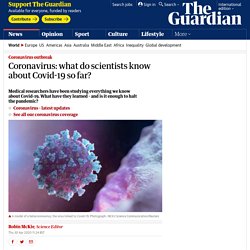
Several versions are known to trigger common colds and more recently two types have set off outbreaks of deadly illnesses: severe acute respiratory syndrome (Sars) and Middle East respiratory syndrome (Mers). But their impact has been mild compared with the global havoc unleashed by the coronavirus that is causing the Covid-19 pandemic. In only a few months it has triggered lockdowns in dozens of nations and claimed more than 100,000 lives. And the disease continues to spread. The race for coronavirus vaccines: a graphical guide. More than 90 vaccines are being developed against SARS-CoV-2 by research teams in companies and universities across the world.
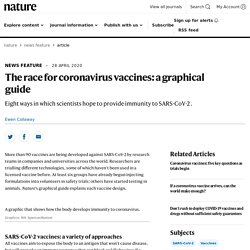
Researchers are trialling different technologies, some of which haven’t been used in a licensed vaccine before. At least six groups have already begun injecting formulations into volunteers in safety trials; others have started testing in animals. Nature’s graphical guide explains each vaccine design. Covid-19. Cases of Covid-19 first emerged in late 2019, when a mysterious illness was reported in Wuhan, China. The cause of the disease was soon confirmed as a new kind of coronavirus, and the infection has since spread to many countries around the world and become a pandemic.
On 11 February the World Health Organization announced that the official name would be covid-19, a shortened version of coronavirus disease 2019. The WHO refers to the specific virus that causes this disease as the covid-19 virus. This is not the formal name for the virus – the International Committee on Taxonomy of Viruses calls it the “severe acute respiratory syndrome coronavirus 2”, or SARS-CoV-2, because it is related to the virus that caused the SARS outbreak in 2003. However, to avoid confusion with SARS the WHO calls it the covid-19 virus when communicating with the public.
Understanding COVID-19: A Primer. As a psychologist, I am not well-versed in the technical language of viruses. As such, I took some time to ask my friend, Dr. Waldemar Schmidt, who is an MD/Ph.D. pathologist some questions about the virus. 1. What is the size of the coronavirus? Robert Eliot’s aphorism applies to our current pandemic: Rule No. 1: Don't sweat the small stuff. Article continues after advertisement 2. In biology, a virus refers to a “submicroscopic, non-cellular structure consisting of a core of DNA or RNA surrounded by a protein coat, that requires a living host cell to replicate, and often causes disease in the host organism" (see here).
It is named a corona virus based on its morphology and shape. 3. There is important information to unpack with this question. COVID-19 (novel coronavirus) questions and answers. This page was last updated 29 April 2020. More detailed information and guidance is provided in the Information for specific audiences section. If you have questions relating to travel, financial support or essential services, please refer to the COVID-19 website.